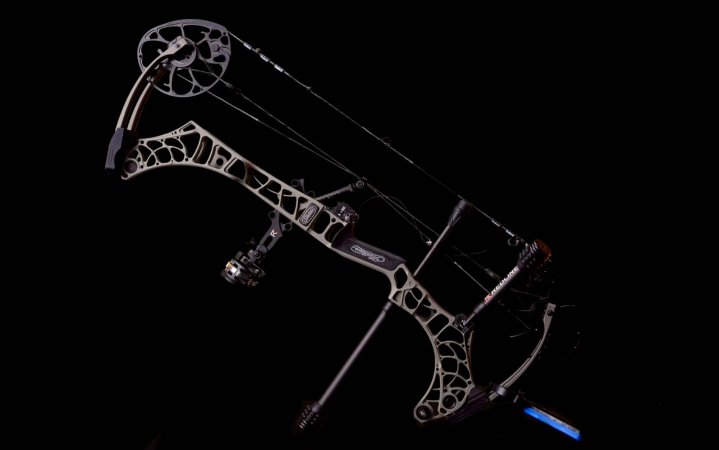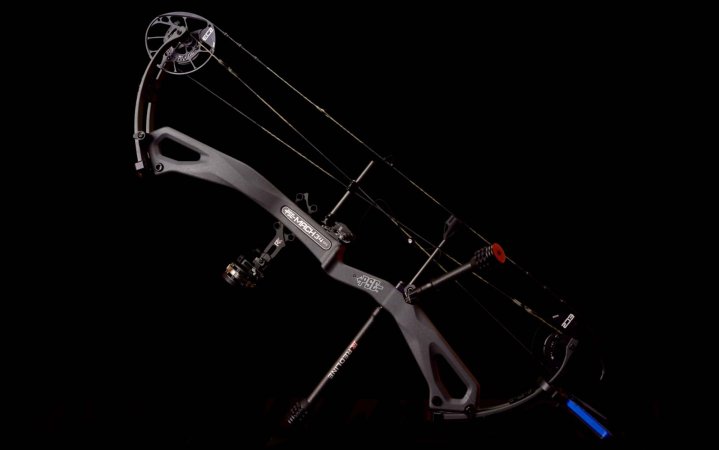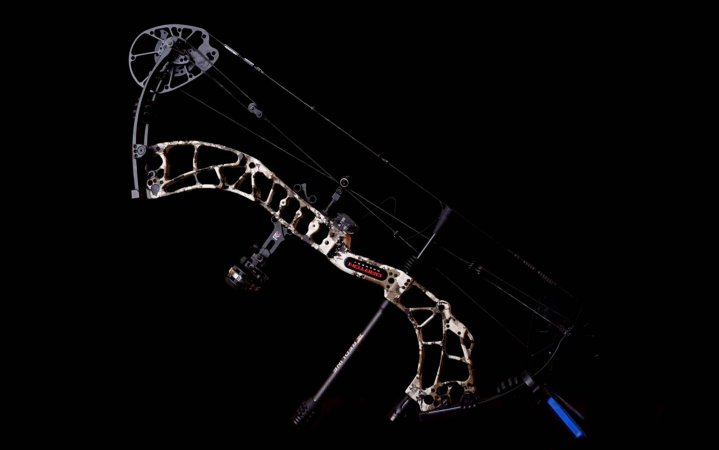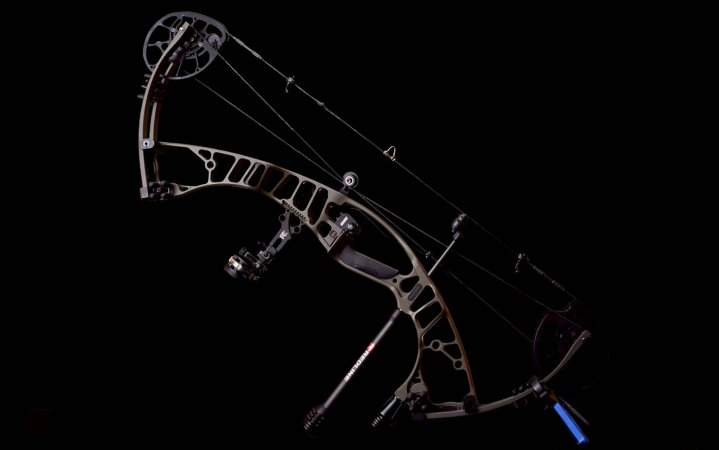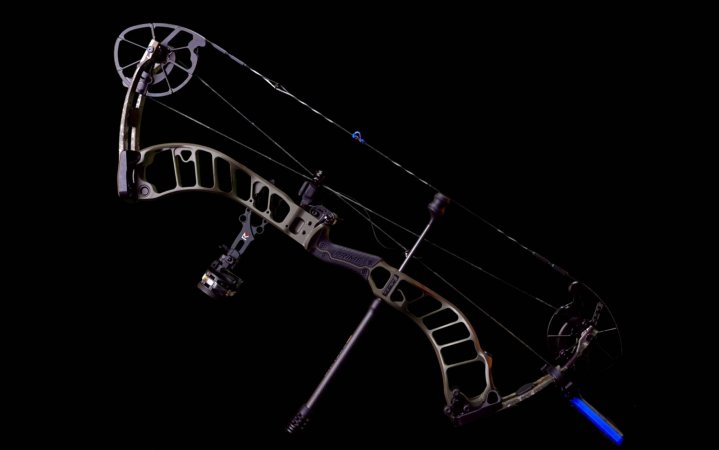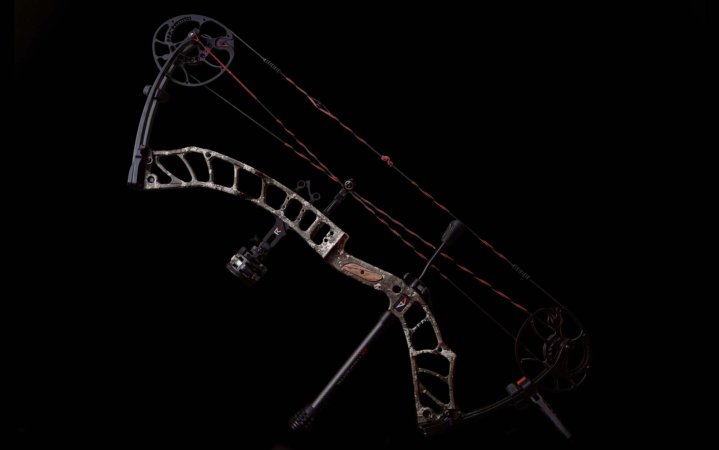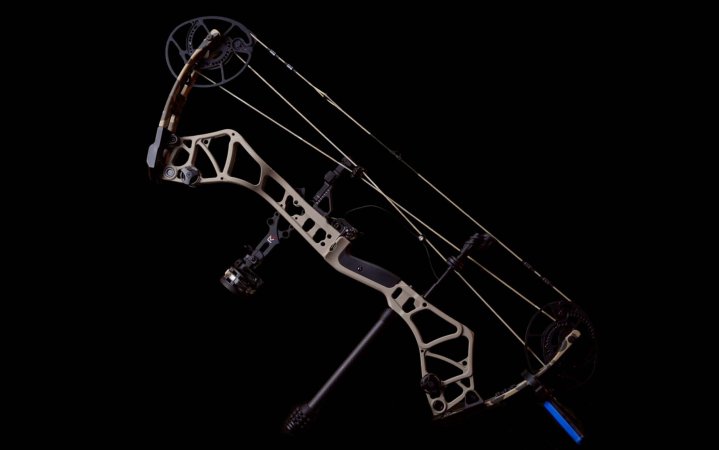We may earn revenue from the products available on this page and participate in affiliate programs. Learn More ›
Speed bows are hard to draw. Carbon bows have a wicked thump and aren’t even much lighter than aluminum bows. You need a bow press to tune a bow and make small draw length adjustments.
As we found in Outdoor Life’s 2023 Bow Test, those statements—previously true—are no longer fact. We tested nine flagship compound bows, one from each of the top manufacturers, with our friends at Lancaster Archery Supply and discovered that a lot has changed in the compound bow manufacturing world. Among the test group, we saw sub 4-pound carbon bows with very little vibration, a speed bow with a similar draw to the smoothest bows in the field, and several models that didn’t need a press to shim cams or adjust draw length in ¼-inch increments.
This year’s flagship compounds are an impressive group of bows that are packed with features and very few compromises. But each bow does have its pros and cons. So the goal of our review is to give you far more information than manufacturer’s specs and basic YouTube video reviews can provide. You’ll find accurate speeds recorded with an actual hunting-weight arrow, accuracy data, and details on the bow’s shooting characteristics. Use that information in conjunction with your personal tastes to choose a few compound bows that you’ll try out at an archery shop.
Click the bows’s name to jump to its review.
-
Editor’s Choice: Elite Era
Mathews Phase 4
PSE Mach 34
Bowtech Carbon One
Darton Prelude
Hoyt VTM
Prime Revex
Blackout NV-32
Bear Execute
How We Tested the Bows
Specs
To get a baseline, we weighed the bows with just the QAD arrow rest and RL-3 sight mounted. All bows were set to 60 pounds (+/- 2 pounds). We set compound bows at 29 inches of draw length and measured the draw length using the ATA standard of the string apex to the pivot point, plus 1.75 inches. We measured exact draw weight and draw length to provide context for the bow’s speed.
Tuning
We timed the cams, set the centershot to the standard 13/16 inch, and set the nocking point height level. Then we paper tuned to a bullet hole to make sure we were doing the speed and accuracy testing with a tuned bow.
The Five-Foot Test
When you try out a bow at an archery shop you’ll likely test it close to the target and judge the bow on how it feels when you draw and shoot it. While shooting a bow for accuracy is an important component of this test, we also tested a bow’s grip, back wall, perceived vibration (post shot), and draw cycle at close range so we could focus on those attributes without worrying about shooting tiny groups. Testers rated each feature on a scale of one to five (five is the best) and provided notes on them. You’ll find the five-foot test scores in the test results section for each bow.
Accuracy

Each tester shot several five-shot groups at 50 yards. All the bows were shot with the same Redline RL-3 sight, QAD Ultrarest, and no stabilizers. The accuracy test is telling because over the 25 arrows recorded for each bow, it becomes apparent that some bows are easier to shoot accurately than others. Those easy-to-shoot bows consistently print smaller groups for a wide range of archers. The most extreme example of this is the difference between our flagship groups and our budget compound bow groups (we averaged 4-inch groups with the flagship bows and 6.5-inch groups with budget bows).
Mantis X8
The Mantis X8 is a small sensor that attaches to a bow’s riser and sends data to the Mantis app. While the testers could subjectively rate if a bow held steady or wobbled like a chicken on tightrope, the Mantis X8 allows us to actually show you what a bow’s float pattern looks like.
We included Mantis data in the reviews for bows that held exceptionally steady and for bows that were more difficult to shoot. The orange line shows a bow’s movement before the shot, and the red line shows a bow’s movement after release. There are two Xs: one for the bow’s position when the arrow was released and one for the bow’s position when the arrow left the bow.
Speed
We shot Easton Axis 5mm shafts in a 350 spine cut to 28.75 inches with a 100-grain field point. The arrows weighed 420 grains overall. Bows were shot at the exact specs listed for each bow (approximately 60 pounds and a 29-inch draw length, see below).

We used a LabRadar doppler chronograph to measure three shots from each bow. We then averaged those three recorded speeds for the final spec. Because everything from a bow’s tune to the weight of the peep can affect a bow’s speed, the speeds listed are meant to provide reference points, not the final word on a bow’s speed. It’s also important to note that all of today’s flagship bows are pretty fast, but what’s more impressive to us is when a bow is easy to draw and still shoots fast.
Stress Engineering

We partnered with Stress Engineering Services’ Outdoor Division to test our lineup of bows. Stress Engineering conducted vibration and sound data. Vibration testing was done using an accelerometer (PCB 353b14), which was screwed into the bow’s stabilizer mount. The sound measurements were taken with a microphone (PCB 378A06), which sent data to an acquisition box that records at 50,000 hertz. The data then went from the acquisition box to a laptop that uses a weighting filter to include only sounds the human ear can hear. The vibration data goes through a filter to record only vibrations the human hand is sensitive to. Each bow was shot three times in a shooting machine for consistency, and the data from the three shots was averaged.
This data can be found in the test results section of each bow.
Choosing the Best Overall Compound Bow
In the 2022 test, we had a hard time choosing between three remarkable bows. This year, after the chronograph, five-foot test, and accuracy portion of the testing, three bows rose to the top: the Elite Era, PSE Mach 34, and Mathews Phase 4. We dedicated a full day to testing those three compound bows.

We set up those three bows with a Redline RL Trio Back Bar and Stabilizer Kit, then shot them from 40 to 80 yards. We were looking to see how the bows aimed and shot when fully set up. We also conducted a forgiveness test with the top three bows.
Good compound bows hit right behind the pin. Really good bows hit the middle even when you’re not shooting great—that’s called forgiveness. We tested forgiveness by simulating three common mistakes archers make when under pressure: creeping, torquing the grip, and pulling hard into the stops. The tester intentionally made each of those mistakes to see if the point of impact changed.
Our final decision came down to the bow that was the most innovative and had everything a bowhunter would want: a smooth draw, no post-shot vibration, low sound levels, features for easy tuning, customization, accuracy, and forgiveness.
Gear We Used for Testing
Chronograph: Labradar
The Labradar uses doppler radar to track a projectile and measure its speed. We chose it over a traditional chronograph because it provides consistent reading no matter the lighting conditions.
Bow Sight: Redline RL-3
The RL-3 is a 3-pin sight with toolless micro adjust, which made it easy to sight in the nine bows in our flagship bow test.
Arrows: Easton Axis 5mm
The Easton Axis 5mm was our pick for the best hunting arrow. It’s a consistent shaft that gave us an arrow weight of 420 grains.
Arrow Rest: QAD Ultrarest
The QAD Ultrarest won best overall in our best arrow rest review. So it was an easy pick to be our arrow rest of choice for the bow test. It offered easy setup, reliability, and accuracy.
Stabilizers: Redline RL Trio Back Bar and Stabilizer Kit
Front and rear stabilizers help refine your pin float and the Redline RL Trio kit makes it easy to stabilize a bow with everything you need in one package.
Other Gear Used
The Test Team
P.J. Reilly: Longtime bow reviewer and video host for Lancaster Archery Supply. Reilly is also an accomplished archer who has bowhunted everything from whitetails to musk ox.
Alex Robinson: Outdoor Life’s editor-in-chief, bow test veteran, and workaday bowhunter.
Scott Einsmann: Outdoor Life’s executive Gear Editor, former archery coach, and lifelong archery nerd.

Editor’s Choice: Elite Era
Specs
- Axle-to-axle: 31.25
- Weight: 4.7 pounds
- Draw Length: 29 inches
- Draw Weight: 59.7
- Holding Weight: 7.7 pounds
- Price: $1,699
Test Results
- Speed: 271.5 fps
- 50-yard Group Average: 3.18 inches
- Build Quality: 5
- Features: 5
- Back Wall: 5
- Draw Cycle: 4.25
- Grip: 5
- Post Shot: 4.75
Each of us had the exact same reaction from our first shot through the Era—we burst into joyous laughter. The insanely low vibration and quiet shot makes the Era a very fun bow to shoot.
We’ve tested a lot of good bows through the years, but sometimes we get one that’s special: a bow that has exceptional innovation, features, performance, and shooting experience. The Era was one of those bows. It all starts with the carbon riser, which incorporates Elite’s bridged design.
“Those bridges definitely help with the rigidity of the riser,” says Josh Sidebottom, Elite’s head engineer.
Sidebottom and his team played around with different types and thicknesses of carbon in different areas of the riser to get the construction and performance just right.
“It took us some time to figure it out and get the right carbon where we needed it,” he says.
The result is a carbon bow that looks and shoots like an Elite, which is to say it looks killer and shoots wonderfully. Another accomplishment is creating that rigidity in the riser without adding a ton of weight (it weighs under 4 pounds bare). The Era is the second lightest bow in the test (it’s about ¼-pound heavier than the PSE Mach 34).

Not only does it have a well-engineered riser, the Era also has SET Technology, ¼-inch draw length adjustments, and micro adjustable holding weight.
SET Technology is one of the best systems for the home bow mechanic. If you want to bare shaft tune or tune fixed blade broadheads, you can do it quickly with the SET system because you don’t need to press the bow, twist yolks, or shim cams—you just need Allen wrenches. Proper draw length is important for steady aiming, and traditionally you’d twist the string and cables to fine tune draw length, but the Era is adjustable in ¼-inch increments with just a set of torx wrenches.
Elite is known for bows that feel lighter than their actual draw weight, but they’ve gone to a more aggressive cam with this bow. The Era doesn’t have that classic, ultra-smooth Elite draw cycle, but we still liked it. The draw starts off smooth and even, and then there’s a spike in effort right before you roll into the valley.
Once you’re at full draw you have a solid wall with just a little give, and a very generous valley. If you want no give in your back wall, you can add the limb stop and you’ll get no movement.

At Stress Engineering, the accelerometer measured a very low impulse for the Era. The 12.5 m/s2 impulse was lower than the Phase 4 (16.9 m/s2) and the Mach 34 (24.7 m/s2). The acceleration impulse measures front to back movement, what archers describe as jump. It doesn’t measure residual vibration, which we commonly call hand shock. The Phase 4 and the Mach 34 did win out in the sound test. The Era averaged 75.9 dBa versus the Mathews’ 74.2 dBa and PSE’s 72.7 dBa.
The Era’s 3.18-inch group average was tied for the best in the accuracy test. All but one group was under 3 inches and Reilly’s group average was 2.5 inches. We noticed the pin settled quickly and the bow felt stable at full draw. You can see that in the Mantis data.


The orange line indicates movement before the shot and you can see it takes a direct path without a lot of side to side movement. For comparison you can see a lot of orange that squiggles in the Blackout NV-32 Mantis reading. That’s an indicator that the archer was aiming the bow for a long period of time and the pin had a lot of movement.
The Era’s excellent grip also helped with accuracy. “The grip is perfect and puts your hand right where it should be,” said Reilly. It has a wide, flat spot for your heel and then narrows toward the throat. It also has decent traction from the bow’s finish.

The Era excelled during the final stage of testing where we shot it from 40 to 80 yards and performed a forgiveness test. We already knew it shot nicely from the 50-yard accuracy testing, but with stabilizers the pin really settled at 80 yards. Even while torquing, creeping, and pulling hard into the stops we didn’t shoot a group larger than 8 inches at 40 yards.
The Era’s riser isn’t made in the USA, which helps keep the price lower than other carbon bows, but some archers will want a bow that’s fully made here at home. That’s the only con we noted for the Era, and it’s not one that has anything to do with build quality or performance.
The Era is a must-try for anyone who wants the most adjustable and easily customizable bow, that’s also light, accurate, and pleasant to shoot. The Era’s innovation, performance, and user-friendly features are why it ultimately won the 2023 Editor’s Choice.
To learn more about the Era, check out P.J. Reilly’s full review.
If aluminum is more your style, read our full review of the Elite Omnia.
Mathews Phase 4
Specs
- Axle-to-axle: 29.06
- Weight: 5.1 pounds
- Draw Length: 29 inches
- Draw Weight: 62.6 pounds
- Holding Weight: 11.3 pounds
- Price: $1,199
Test Results
- Speed: 279 fps
- 50-yard Group Average: 3.5 inches
- Build Quality: 4.75
- Features: 5
- Back Wall: 4.75
- Draw Cycle: 4.75
- Grip: 5
- Post Shot: 5

Mathews is no stranger to the top of our bow rankings. Last year, it came down to the V3X and the PSE Levitate for bow of the year, and the Levitate won out because it was such an innovative design. We had some bow test deja vu as we found ourselves once again deciding between a Mathews and an innovative carbon bow.
Mathews keeps producing bows we love to shoot, and they’ve somehow managed to make the Phase 4 even quieter with less vibration than the V3X. That is likely due, in part, to their new limb design, which includes a rubber dampener down the middle of each of the four limbs. The other features on the Phase 4 are an Integrate arrow rest mount, SwitchWeight Mod, Stay Afield System (portable bow press), and Bridgelock sight and stabilizer mount.

The Mathews requires a good amount of effort to get its big cams rolling, but once you start the draw, it’s easy all the way to the back wall with no humps and a smooth transition into the generous valley. The bow aims really well bare, and once we put stabilizers on, it was impressively stable. The groups at 50 yards were among the smallest in the field. We also shot it at 60 and 80 yards as we narrowed the top bows. It shot some impressive groups at those ranges and, again, it was very easy to aim.
One area of testing where we saw the Phase 4 struggle was the forgiveness test. When we pulled hard into the stops and creeped, arrows consistently sailed high. Our best guess was that the grip angle caused us to put more heel pressure into the grip.


The main downside of the Phase 4 is the grip. It’s too rounded without defined edges, which made it easier for us to torque. It’s just a tough grip to shoot well, but you can remove it and shoot on the bare riser. We ended up doing that as we got deeper into testing and it made the Phase 4 easier to shoot accurately. Another downside is that if you want to change draw weight, holding weight, or draw length, you have to buy a new mod.
We can’t help but think that the Phase 4 is an ideal bow for whitetail hunters because of its smooth draw and quiet shot.
Read our full Mathews Phase 4 review to learn more.
PSE Mach 34
Specs
- Axle-to-axle: 34.06 inches
- Weight: 4.5 pounds
- Draw Length: 29 inches
- Draw Weight: 59.7 pounds
- Holding Weight: 9 pounds
- Price: $1,799
Test Results
- Speed: 264 fps
- 50-yard Group Average: 3.18
- Build Quality: 5
- Features: 4
- Back Wall: 4.5
- Draw Cycle: 4
- Grip: 4.75
- Post Shot: 4

Building a bow that’s light and has a rigid riser is extremely difficult. That’s why we’ve seen so many carbon bows that weigh just a few ounces less than their aluminum counterparts. The PSE Mach 34 is a full pound less than the PSE Omen, which is an aluminum bow that’s an inch shorter axle-to-axle.
Not only is the Mach 34 impressively light at 3.65 pounds bare, but the riser is rigid and it has very little thump when you release a shot. That’s accomplished by the proprietary Dead Frequency carbon. Another feather in the Mach 34’s cap is that all 136 layers of carbon in each riser are hand laid in the U.S. According to Lonnie Workman, PSE’s vice president of sales, they have employees dedicated to hand building carbon risers. Even the most skilled makers can only produce six risers per day.
With that attention to detail, it’s easy to see why the PSE Levitate won our 2022 Editor’s Choice, and why the Mach 34 was one of the top bows in our 2023 test.
The Mach 34 has the same beefed up ¼-inch axles and bearings as the Levitate. Just like a riser, flex in the axles is a bad thing for consistency. Over time, lesser bearings can develop flat spots, which turn a smooth-drawing bow into one that’s difficult to draw.

A new feature for 2023 PSE bows is the EZ.220 system. If you’ve ever tried to shim a PSE cam, you’ve probably also spent time searching the floor for spacers. Well, you won’t be doing that anymore thanks to this new spacer system. Instead of a washer, there’s a clip that snaps onto the axle, which makes them easy to take off and reposition for tuning adjustments. You still have to press the bow, but the process is much faster.
Long-draw archers should be especially happy about the Mach 34 since they can finally own a premium carbon bow that goes to a 33-inch draw length. I’m one of those archers and I think the bow draws smooth, though the transition into the valley is more abrupt at 33 inches than at 29 inches. I’ve continued to shoot the Mach 34 after our test and have found it accurate and stable at full draw with a low-vibration post shot.
The Mach 34 draw cycle takes effort to get started, but once you get the cams rolling the draw is very smooth all the way to the back wall. There’s no second hump, and the transition into the valley lacks any sudden drop off.
Two cable stops provide a solid back wall and the valley is very forgiving of slight creeping. On the shot, you’ll feel a slight thump, but it’s not an unpleasant one. In fact, the Mach 34 received a 4 out of 5 in the post shot category of 5-foot test. But, it’s not completely dead in the hand like the Phase 4. We saw this in the accelerometer readings where the Mach 34 had a 24.7 m/s2 impulse and the Phase 4 had a much lower 16.9 m/s2 impulse.

The Mach 34 tied the Era for the best group average with 3.18 inches. It was Robinson’s most accurate bow: he shot a 2.5- and 2.75-inch group. The Mach 34 was in the group of three top bows that were setup with stabilizers and shot out to 80 yards while determining the editor’s choice pick. The stability at full draw was excellent bare, but it got even better with the stabilizers and we saw slow, predictable pin movement. Due to its axle-to-axle length, we do think the bow would benefit from a 15-inch front bar and 10-inch back bar, rather than the 12-inch front and 8-inch back bar we used.
In the forgiveness test, the Mach 34 kept arrows inside an 8-inch group at 40 yards despite Reilly and Robinson’s best efforts to pull hard into the stops, creep, and torque the grip.
PSE has one of the best grips on their aluminum bows, and they’ve been able to translate that success to carbon. The grip is flat with defined edges and is .7-inch wide from the heel to the throat. The result is a grip that promotes consistency and allows you to feel when you’re torquing.
The EZ.220 system is easy to use, but it still requires a bow press unlike tuning systems like SET Technology and DeadLock.
Hunters who want the lightest bow possible, but also want a bow that’s accurate and forgiving, should try the Mach 34 at an archery shop. We recommend shooting it back-to-back with the Elite Era since both bows are so similar in their use cases.
Read Next: Best Trail Cameras
Bowtech Carbon One
Specs
- Axle-to-axle: 30 inches
- Weight: 5.2 pounds
- Draw Length: 29 inches
- Draw Weight: 62.7 pounds
- Holding Weight: 7.3 pounds
- Price: $1,799
Test Results
- Speed: 268.5 fps
- 50-yard Group Average: 3.5 inches
- Build Quality: 4
- Features: 5
- Back Wall: 4.75
- Draw Cycle: 4.75
- Grip: 3.75
- Post Shot: 4
We were critical of the 2022 Bowtech SR350 at last year’s test because on the “performance setting” the draw cycle was no fun to shoot. But redemption has never felt so smooth.
Most bows feel like rolling a boulder down a hill. It’s hard to get them started, but then it gets easier once things are moving. The Bowtech Carbon One is like rolling a marble across a glass table. It’s just insanely smooth and easy to draw the whole way back. It was the smoothest-drawing bow of our test.

The Carbon One is also one of the most feature-rich compound bows in this year’s test. The signature Bowtech feature is the DeadLock cam, which allows you to adjust the cam left and right with nothing more than an Allen wrench. It also has a modular grip, so if you like a higher wrist grip, you can add on a different grip module for a higher angle. The FlipDisc on the cam allows you to choose a “performance” or “comfort” setting for either a faster bow or an easier to draw bow. It also has a flexible cable guard, dovetail rest mounting, vibration dampeners, and well-designed limb pockets. Of course it’s a carbon bow too.
Fellow archery nerds will appreciate the ease of tuning you get with the DeadLock system. And Bowtech includes nice touches like hardened stainless steel mod screws. It’s so easy to strip standard, non-hardened screws; the fact that Bowtech thought about that detail and includes stainless screws tells us Bowtech is in touch with the needs of bow mechanics.

The Carbon One tied the Mathews Phase 4 in the accuracy testing with a 3.5-inch group average, the second smallest group average in the field. The wide limb stance, smooth draw, and really nice wall made the bow easy to shoot well. On the release, the bow had a little thump to it, but it wasn’t bad compared to carbon bows we’ve shot in the past. But we felt it was more than the Mach 34 and Era. Again the objective accelerometer data confirmed what we noticed while shooting. The Carbon One had a 28.9 m/s2 impulse which was double that of the Era and little more than the Mach 34’s 24.7 m/s2 impulse.
The grip, however, was not our favorite. We found it too slick and too thin, and the rounded edges make it hard to feel exactly where you’re putting pressure. If we were to buy a Carbon One, we’d wrap the grip with hockey tape for traction.
Bowtech did a great job building a smooth drawing bow, but it’s a carbon bow that weighs the same as the CP30, an aluminum bow of equal length. So, you’re not getting the weight benefit that a carbon bow should offer.
But, if you bowhunt from a treestand in frigid temperatures or have to draw while being stared down by an elk, an easy-drawing bow like the Carbon One is a good option. It’s also one of the best bows for the home bow mechanic.
Darton Prelude
Specs
- Axle-to-axle: 32.25
- Weight: 5.7 pounds
- Draw Length: 29 inches
- Draw Weight: 63 pounds
- Holding Weight: 11.7 pounds
- Price: $1,145
Test Results
- Speed: 286.3 fps
- 50-yard Group Average: 5.37
- Build Quality: 4
- Features: 4
- Back Wall: 4.75
- Draw Cycle: 3.75
- Grip: 3.75
- Post Shot: 4.75
If you haven’t been paying attention to the compound bow industry, Darton has been building high-quality bows the last few years. They’re making big moves in the target archery world with pros like Tanja Gellenthien, Jimmy Lutz, and Chance Beaubouef shooting Darton models, and winning with them. They also developed and own patents on many of the key compound bow design features used by other manufacturers.

Darton builds strong, beefy risers from 7075 T-6511 aluminum, which has a high strength-to-weight ratio. The company also redesigned its riser for more rigidity. The Prelude’s wide limb stance further increases stability and Darton made the limbs parallel to help reduce vibration. Darton uses ¼-inch axles and ⅝-inch bearings, which again adds reliability and rigidity.
The cams use Darton’s E system which is a new take on yolks. With three points of contact instead of two, the E system evens pressure on the axles and contributes to accuracy. The cams are adjustable for draw length in ¼-inch increments and there are eight settings for holding weight. The bow also has a dovetail rest mount and an adjustable cable guard. That’s a lot of great features in one bow.
This was the fastest bow in our test at 286.3 fps, but it doesn’t feel like a speed bow when you draw it. It has a very even draw cycle, similar to the Bowtech, but it feels like it takes more effort throughout the draw cycle compared to the Carbon One. The back wall is as good as it gets thanks to two large, flat cable stops.
At 5.37 inches, the Prelude had the second-highest group average. It felt good at full draw, but we had issues getting five good shots out of it.
We liked the Prelude’s grip and could feel exactly where we were putting grip pressure. The only improvement we’d make is adding some traction with hockey tape.
At the release, the bow behaves really nice with very little vibration or jump. That’s especially impressive considering the bow’s speed.
The Prelude is one of those special bows that offers speed without sacrificing a smooth draw. It’s also loaded with features for customizing fit and at under $1,200 it’s a great value.
Read Next: Best Bow Sights
Hoyt VTM
Specs
- Axle-to-axle: 33.75 inches
- Weight: 5.7 pounds
- Draw Length: 29 inches
- Draw Weight: 62.1
- Holding Weight: 11.7
- Price: $1,449
Test Results
- Speed: 281 fps
- 50-yard Group Average: 4 inches
- Build Quality: 4.5
- Features: 4
- Back Wall: 4
- Draw Cycle: 4
- Grip: 3.75
- Post Shot: 4


Even from a distance, there’s no mistaking a VTM 34 for anything other than a Hoyt. It has Hoyt’s signature bridged riser and all of Hoyt’s latest features like the Picatinny sight mount, dovetail arrow rest mount, short stop stabilizer, and binary HBX cams. It’s also compatible with low-profile quivers (inline setups are a trend with many of the flagship bows in recent years).
The VitalPoint grip has a comfortable, rubbery texture, which should provide traction even when your palms are sweaty. It’s shaped so that your hand naturally finds a proper grip and the low wrist angle is comfortable to shoot.
Once you get past the usual initial effort to start the draw, the VTM 34 is smooth through the middle of the draw cycle. Then there’s one final hump to pull through before the cams roll over into the valley.
The back wall has some give. Reilly described it as pulling into clay rather than concrete. The valley is deep and there’s no concern about the bow taking off on you if you relax a little.
The VTM 34 wasn’t the best but it was far from the worst-shooting bow. Its 4-inch group average was right in the meaty part of the curve.
Hoyt has one of the better compound bows for inline accessories. The Picatinny mount on the riser cuts out a lot of bulk and weight from sights. The dovetail mount and low profile quiver compliment the sight mount really nicely, and it makes for a bow that feels bare when it’s fully kitted out.
Prime Revex
Specs
- Axle-to-axle: 32.06 inches
- Weight: 5.1 pounds
- Draw Length: 29 inches
- Draw Weight: 60.9 pounds
- Holding Weight: 9.2 pounds
- Price: $1,299
Test Results
- Speed: 272.6 fps
- 50-yard Group Average: 3.93 inches
- Build Quality: 4
- Features: 3
- Back Wall: 4
- Draw Cycle: 4
- Grip: 3
- Post Shot: 3.75

Prime isn’t afraid to make big changes to their bows, and just like last year, they went to a brand-new cam design for 2023. At rest, the Core cam’s cables sit off to the side of the bowstring. But as you draw the bow, the cables shift toward the cam so that, at full draw, both cables and the bowstring are in line with one another and the cam. Prime’s engineers say that evens the load on the cam, preventing cam lean and improving tunability.
Another big change is that if you want to change your draw length, you have to buy a new module from a Prime dealer. That’s a departure from the easy adjustments and home-bow-mechanic-friendly features we see on other flagships. The upside is that draw-length-specific mods are typically more efficient than rotating modules.
Reilly and Robinson had very different impressions of the draw cycle during the five-foot test. Reilly said the bow took effort to get started, but then drew very evenly and was exceptionally smooth transitioning into the valley. Robinson felt like the draw was easy to start, but had a big hump to pull through before the valley. I broke the stand off with my five-foot test. I think the Prime Revex is easy to start, stays smooth and easy, and then has a slight hump to pull through before the valley. Overall, I really liked the draw cycle.
All the testers agreed that the bow held great at full draw and had very little noise or vibration after the shot. We also agreed that the grip felt too rounded for consistent pressure and placement. One cool thing is that underneath the grip, Prime coats the riser with Aerogel, a NASA-developed material to prevent cold from transferring from the aluminum to the grip.
If you’ve never shot a Prime or you haven’t like past Prime bows, we’d recommend giving this one a try because it’s so different from the company’s past models.
Read our full Prime Revex review for more information.
Blackout NV-32
Specs
- Axle-to-axle: 32 inches
- Weight: 5.1 pounds
- Draw Length: 29 inches
- Draw Weight: 62.5 pounds
- Holding Weight: 11.2 pounds
- Price: $800
Test Results
- Speed: 274 fps
- 50-yard Group Average: 4.75 inches
- Build Quality: 2
- Features: 3
- Back Wall: 3.25
- Draw Cycle: 3.5
- Grip: 3.5
- Post Shot: 2.75

If you’re wondering Who the heck is Blackout?, you’re not alone. It’s the Bass Pro Shops/Cabela’s brand, and the NV-32 is the store’s flagship offering. This particular Blackout bow is made by Elite for Bass Pro, and while this bow certainly isn’t an Elite, you can still identify some of the company’s design ethos.
During Reilly’s 5-foot test, he shot the bow and held his follow through for a few seconds while saying, “aaaand now the bow stopped vibrating.” We thought he was joking at first, but he wasn’t. This bow doesn’t have a hard thump, but it also has a humming vibration that lasts well after the shot. It could greatly benefit from added vibration dampeners.
The NV-32 is smooth-drawing, but the back wall is soft due to give in the hybrid cam’s cables. The grip is way too rounded for consistent placement and pressure. The combination of the soft wall and grip required extra work to hold the bow on target at full draw.
That’s the bad news. The good news is that the NV-32 shot decent groups. The 4.75-inch average was the third largest, but it’s still only .75 inches larger than the Phase 4. And it shot a respectable speed while maintaining a smooth draw.
We didn’t love the NV-32 for a lot of reasons, but it’s not a terrible bow. It’s worth considering that while this is a flagship offering, it’s half the price of many bows we tested. This is the bow for the person who wants to buy a flagship bow with decent performance, and wants to buy it online. If you don’t have a bow shop or if Cabela’s or Bass Pro are the only place you have to buy archery equipment, then the NV-32 is worth considering.
Bear Execute
Specs
- Axle-to-axle: 30 inches
- Weight: 5.6 pounds
- Draw Length: 29 inches
- Draw Weight: 60.6 pounds
- Holding Weight: 8.4 pounds
- Price: $1,199
Test Results
- Speed: 275.3 fps
- 50-yard Group Average: 5.43 inches
- Build Quality: 3
- Features: 2
- Back Wall: 3.75
- Draw Cycle: 3.25
- Grip: 3
- Post Shot: 2

Bear Archery added features to their flagship Execute that a lot of bowhunters will appreciate. Bear has gone to a wider limb, which improves stability. The company has also redesigned its limb pocket to be more stable, which helps accuracy, and also added new vibration dampeners. Other great features are adjustable let-off, a limb stop, two grip options, and a level built into the riser that helps you set up your sight.
The Execute lost points in the draw cycle score because of the big spike in effort you have to pull through right before the valley. When you have to exert a bunch of effort before the let-off, it’s hard to smoothly hit the back wall. When you don’t smoothly hit the back wall, you get a lot of sight movement, and then you have to wait for your pin to settle.
The back wall is as solid as it gets if you use the limb stop, but it’s soft if you go with the cable stops. The wide, soft rubber grip is very comfortable, but it wasn’t great for consistent accuracy. Bear does have a slimmer grip option though.
The group average was the largest among our nine flagship bows at 5.43 inches. We found the Execute a difficult bow to shoot. Three of the four groups were above six inches, though Robinson had one group that was 2.5 inches.
The post shot wasn’t pleasant, and the bow is far from dead in the hand. The data from Stress Engineering is helpful for understanding what we felt when we shot the Execute. The impulse reading for the Execute was 20.1 m/s2 so it doesn’t have much jump and was very close to the Prime Revex’s 21 m/s2. But it does have post-shot vibration and you can feel that buzzing sensation in your hand.
Final Thoughts on the Best Compound Bows
Last year the Mathews V3X was a great value at $1,099; this year’s Phase 4 is still a solid value, but it costs $1,299. Last year’s Hoyt Ventum Pro 33 was $1,349 and this year’s Hoyt VTM 34 is $1,449. We can’t blame archery companies for the price jump because it’s simply due to material costs increasing. But, prices are going to be a factor for compound bow buyers in 2023.
One of the more exciting trends is that bows continue to be more adjustable and easier to tune. Archery equipment preferences vary so much from person to person, and the ability for a bow to fit a person’s preferred grip and their exact draw length is a major value add.
If you’re shopping for a bow in 2023, consider the features that are most important to you and use the data from our test to choose a few with those characteristics. Head to your nearest dealer, and spend time shooting those bows before you make your final decision.


